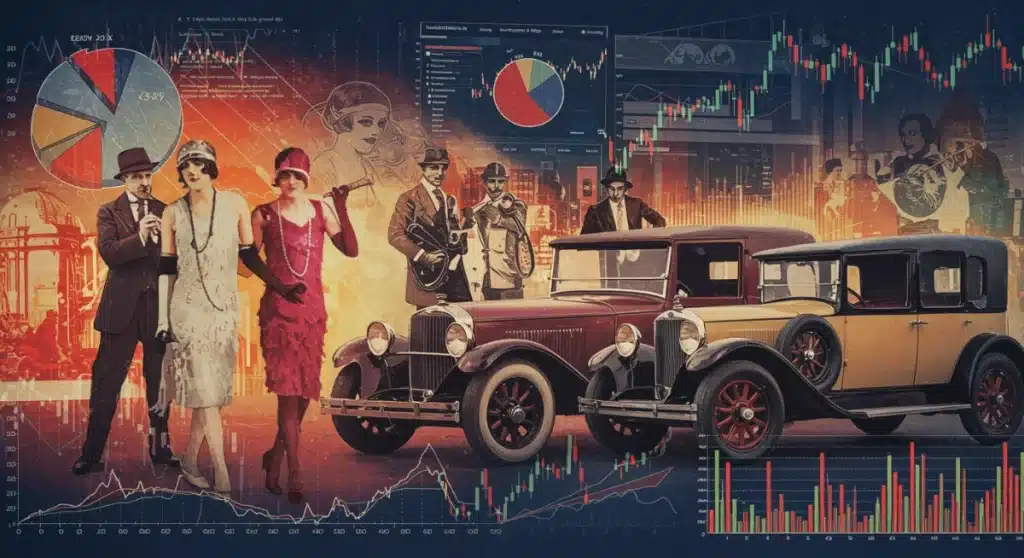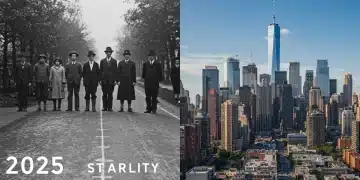Roaring Twenties Revisited: Economic Lessons for 2025 Market

The Roaring Twenties’ economic booms and busts provide essential historical context for anticipating potential market behaviors and policy responses relevant to the 2025 economic landscape.
As we approach 2025, a critical examination of economic history becomes increasingly pertinent. The period known as the Revisiting the Roaring Twenties: Economic Booms and Busts and Their Relevance to 2025’s Market offers a unique lens through which to view current trends and potential future scenarios. Understanding these historical cycles can provide invaluable insights into today’s rapidly evolving global economy.
Echoes of the Past: Economic Parallels to the 1920s
The 1920s, often romanticized as a decade of unprecedented prosperity and cultural change, was also a period of significant economic volatility. Examining the undercurrents of this era reveals striking similarities to our current economic climate, particularly as we look towards 2025.
This historical perspective helps us identify patterns in innovation, market behavior, and regulatory challenges. The rapid technological advancements, speculative investments, and shifting global power dynamics of the 1920s are not entirely dissimilar to the digital revolution, meme stock phenomena, and geopolitical realignments defining the early 2020s.
Technological Innovation and Market Excitement
- Automobile Revolution: The 1920s saw widespread adoption of the automobile, transforming industries and consumer habits.
- Radio Broadcasting: The emergence of radio created new forms of entertainment and advertising, fostering a sense of national community.
- Electrification: Increased access to electricity boosted industrial productivity and household convenience.
These innovations fueled immense market excitement and investment, often leading to overvaluation. Today, AI, biotechnology, and renewable energy sectors are experiencing similar levels of transformative innovation and investor enthusiasm.
The Boom Cycle: Prosperity and Speculation
The economic boom of the Roaring Twenties was characterized by robust industrial output, rising wages, and a surge in consumer spending. This prosperity, however, was accompanied by a speculative fervor that permeated various asset classes, from real estate to the stock market.
The era saw a significant expansion of credit, making it easier for individuals and corporations to borrow and invest. This accessibility to capital, while initially stimulating growth, also laid the groundwork for unsustainable practices and inflated asset prices. The belief that economic growth would continue indefinitely fueled a sense of invincibility among investors.
Unchecked Market Optimism
The stock market became a playground for both seasoned investors and ordinary citizens. Stories of quick riches encouraged more people to participate, often with borrowed money. This widespread participation, fueled by margin buying, amplified market movements.
- Margin Buying: Investors purchased stocks with as little as 10% down, borrowing the rest, which magnified both gains and losses.
- Investment Trusts: Popular pooled investment vehicles promised high returns, attracting capital but often lacking transparency.
- Real Estate Bubbles: Regions like Florida experienced massive land speculation, driving prices to unsustainable levels before collapsing.
The prevailing sentiment was that the market could only go up, leading to a detachment of stock prices from underlying corporate earnings. This unbridled optimism blinded many to the accumulating risks within the financial system.
The Bust: Triggers and Consequences of the Great Depression
The eventual bust of the Roaring Twenties culminated in the stock market crash of October 1929 and ushered in the Great Depression. While the crash was a dramatic event, it was the result of a confluence of underlying economic weaknesses and policy failures.
Key triggers included overproduction in agriculture and industry, leading to falling prices and reduced profits, and an increasingly unequal distribution of wealth that limited overall consumer demand. The global economic landscape, already strained by post-World War I reparations and protectionist trade policies, also played a significant role.
Systemic Vulnerabilities Exposed
The sudden loss of confidence following the market crash led to a vicious cycle. Banks, heavily invested in the stock market and facing widespread withdrawals, began to fail. Businesses, unable to secure loans or sell their products, cut production and laid off workers, leading to mass unemployment.
- Bank Failures: Thousands of banks collapsed, wiping out savings and further restricting credit.
- Deflationary Spiral: Prices plummeted as demand evaporated, making debts harder to repay and discouraging investment.
- Protectionist Policies: The Smoot-Hawley Tariff Act exacerbated the global economic downturn, stifling international trade.
The aftermath was a decade of economic hardship, demonstrating the profound and long-lasting consequences of unchecked speculative booms and inadequate regulatory frameworks.
Regulatory Responses and Economic Policy Shifts
In the wake of the 1929 crash and the ensuing Great Depression, governments worldwide, particularly in the United States, implemented significant regulatory reforms. These measures aimed to prevent a recurrence of such a severe economic collapse and to stabilize financial markets.
The New Deal in the U.S. introduced a series of programs and regulations designed to provide relief, recovery, and reform. These included the establishment of social safety nets, stricter oversight of banks and financial institutions, and efforts to stimulate the economy through public works projects.
Foundational Changes in Financial Oversight
The regulatory landscape was fundamentally reshaped, creating institutions and rules that are still in place today. The goal was to instill greater transparency and accountability in the financial system, protecting investors and consumers from the excesses of unchecked speculation.
- Securities and Exchange Commission (SEC): Established to regulate the stock market and protect investors from fraud.
- Federal Deposit Insurance Corporation (FDIC): Created to insure bank deposits, restoring public confidence in the banking system.
- Glass-Steagall Act: Separated commercial and investment banking, reducing speculative risks taken by deposit-holding institutions.
These reforms marked a shift towards greater government intervention in the economy, recognizing the need for safeguards against market failures and systemic risks. This period established a precedent for regulatory action during times of economic crisis.
Comparing the 1920s to 2025: Modern Market Dynamics
Drawing parallels between the 1920s and the projected economic landscape of 2025 is not about predicting an exact repeat, but rather identifying similar patterns and potential vulnerabilities. Today’s market is characterized by rapid technological change, global interconnectedness, and evolving financial instruments, all of which present unique challenges and opportunities.
The current environment sees significant investment in emerging technologies like artificial intelligence, renewable energy, and biotechnology, much like the innovation drive of the 1920s. This innovation fuels optimism but also raises questions about valuation and sustainability.
Key Differences and Similarities
While the underlying human behavioral aspects of booms and busts remain, several structural differences exist. Today’s financial markets are far more regulated, with central banks possessing more sophisticated tools to manage monetary policy. However, new forms of speculation, such as in cryptocurrencies and certain tech stocks, present novel challenges.
- Global Interconnectedness: Economic shocks can spread more rapidly across borders today than in the 1920s.
- Digital Assets: Cryptocurrencies and NFTs introduce new forms of speculative assets with unique regulatory complexities.
- Central Bank Policies: Modern central banks have more experience and tools for managing inflation and economic downturns.
Understanding these distinctions is crucial for policymakers and investors aiming to navigate the complexities of the upcoming years. The lessons from the past serve as a guide, not a prophecy.

Lessons Learned: Navigating Future Economic Cycles
The primary lesson from Revisiting the Roaring Twenties: Economic Booms and Busts and Their Relevance to 2025’s Market is the importance of vigilance and prudent risk management. Economic cycles, while influenced by unique circumstances, often share common threads of innovation, speculation, and eventual correction.
For investors, this means maintaining a diversified portfolio, avoiding excessive leverage, and performing thorough due diligence. For policymakers, it involves balancing the promotion of innovation with robust regulatory oversight to prevent systemic risks from accumulating. The challenge lies in fostering growth without enabling reckless speculation.
Strategies for Resilience
Building economic resilience requires a multi-faceted approach that incorporates both individual financial planning and broad macroeconomic policy. Education about financial literacy and historical market behavior is paramount.
- Diversification: Spreading investments across different asset classes and geographies to mitigate risk.
- Debt Management: Avoiding excessive personal and corporate debt that can amplify downturns.
- Regulatory Adaptability: Governments and financial institutions must continually adapt regulations to new market realities and innovations.
The insights from the Roaring Twenties underscore that while prosperity is desirable, it must be built on sustainable foundations. Ignoring the warning signs of speculative bubbles can lead to severe and widespread economic distress, a lesson that remains highly relevant as we prepare for 2025.
| Key Economic Theme | Relevance to 2025 Market |
|---|---|
| Technological Booms | AI and biotech innovations drive market excitement, mirroring 1920s auto and radio booms, potentially leading to overvaluation. |
| Speculative Investment | Current retail trading and digital asset surges echo 1920s margin buying, indicating potential risks if unchecked. |
| Regulatory Evolution | Post-1929 reforms inform today’s need for adaptive regulation in new markets like crypto to prevent systemic failures. |
| Global Economic Interdependence | Trade wars and geopolitical shifts have amplified global economic sensitivity, unlike the more localized 1920s downturns. |
Frequently Asked Questions About 1920s Economics and 2025 Outlook
The Roaring Twenties boom was primarily driven by rapid technological advancements like automobiles and radio, increased industrial production, mass consumerism fueled by credit, and a generally optimistic post-war sentiment. This led to significant wealth creation and market expansion.
Speculative investment, particularly widespread margin buying, allowed investors to purchase stocks with minimal upfront capital. This inflated stock prices detached from actual corporate value. When confidence faltered, a cascade of margin calls triggered rapid sell-offs, leading to the crash.
Post-Depression, the U.S. established the SEC to regulate financial markets and the FDIC to insure bank deposits. The Glass-Steagall Act separated commercial and investment banking. These reforms aimed to restore confidence and prevent future systemic financial crises through stricter oversight.
While not identical, some current indicators like elevated valuations in certain tech sectors, increased retail investor participation in speculative assets (e.g., cryptocurrencies), and rising national debt levels draw parallels. However, stronger regulatory frameworks and central bank tools exist today.
Historical lessons emphasize diversification, avoiding excessive leverage, and understanding market cycles. For 2025, this means being wary of overvalued assets, monitoring global economic shifts, and prioritizing long-term, sustainable investments over short-term speculative gains to build resilience.
Looking Ahead: Navigating the 2025 Economic Landscape
As we move closer to 2025, the parallels with the Roaring Twenties serve not as a prophecy of doom, but as a crucial historical reference point. Policymakers and investors must remain acutely aware of the potential for speculative bubbles, the impact of technological disruption, and the critical need for adaptive regulatory frameworks. The ongoing debates around inflation, interest rates, and the future of work all resonate with challenges faced a century ago. Vigilance, informed decision-making, and a commitment to sustainable growth will be paramount in shaping a resilient economic future.





